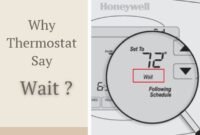A thermostat at home is used to keep the temperature in optimal conditions. Unfortunately, the states cannot be set to the best if the unit is not working correctly. So how do you solve the problem of the thermostat not shutting off at temp of your desire?
Some reasons make the unit not shut off properly. As a homeowner, you must know why and how to fix it. Therefore, you can have a pleasant time at your own house. Hence, this article will conclude why the thermostat is not shutting off properly and other helpful information.
Thermostat Not Shutting Off at Temp
A thermostat that won’t turn off isn’t a minor inconvenience; it’s a significant issue. The thermostat regulates heating and cooling, ensuring your home remains comfortable under all weather conditions.
Not only does it affect your comfort, but it can also impact the efficiency of your entire heating system and air conditioning units, making a thermostat setting that fails to respond to a critical problem to address promptly.

This thermostat will turn on and off the machine to maintain the temperature at the desired temperature. Since the thermostat’s work is often unnoticeable, if there are changes in the temperature, unlike when it used to be, you can conclude that there is some fault at this unit.
The problem could be in many areas. However, it is expected that the faulty thermostat is because of the wiring, connections, and settings.
Read also: Creaking Noise in Water Heating System
How To Deal with Faulty Thermostat:
If you observe abnormal temperature fluctuations at home, remain calm and carefully check the thermostat and fan settings. These fluctuations often indicate a problem with the thermostat itself or related systems. A clogged air filter, for instance, could restrict air flow, making it seem like the thermostat is malfunctioning.
Similarly, fan runs that only run in “on” mode rather than being set to auto might cause the blower to run continuously. After confirming the thermostat’s role in the issue, proceed with the following corrective measures.
- Connections Checking
The first thing to do is check the connections to your thermostat. That is because your unit is not shutting off properly. After all, the device cannot read the temperature well. Therefore, you should focus on the wiring and sensor of the device.
The wiring and sensor could become rusty or faulty for its age. The fault could also be because of the home’s exposure to dirt or pests. Also, cut the wiring loose and replace them again.
- Switch the Thermostat Batteries
The other thing you could do is switch or change the batteries. This could work if you use a thermostat that uses a battery as its power source. Change the old batteries with the new ones to work correctly again.
A weak battery could cause abnormal behavior in the unit. Therefore, inaccurate temperature readings could happen. If your thermostat is electric, the problem might be with its internal system.
- Call An Expert
If you have trouble understanding the system of the unit, it might be challenging to repair it. The best thing you could do is use advice from experts. Therefore, the team could work properly, and you are not waste time solving it alone.
How Long Should AC Run After Reaching Temperature
If the AC or the air conditioner has reached a specific temperature set on the thermostat, it will run for a while before it can turn off. Usually, the time is relatively short. It is between 15 to 20 minutes at least. Between those times, the unit is still on while the compressor is already shutting down.
The air conditioner could run 24 hours a day without getting any damage. Furthermore, it is said that the air conditioner could run for a week without turning off.
Conclusion
The issue of a thermostat not shutting off at the desired temperature can significantly detract from your home’s comfort level. It is vital to identify whether a dirty air filter, incorrect thermostat settings, or issues with the blower motor are to blame.
Enlisting a repair service to fix the issue can ensure that your thermostat and, by extension, your climate control systems operate efficiently and effectively, maintaining your home’s comfort and air quality.
Act promptly to diagnose and address these issues to prevent them from escalating into larger, more costly repairs.


